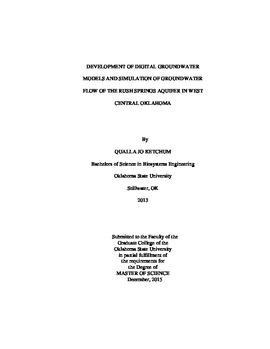| dc.contributor.advisor | Fox, Garey A. | |
| dc.contributor.author | Ketchum, Qualla Jo | |
| dc.date.accessioned | 2017-02-22T22:12:47Z | |
| dc.date.available | 2017-02-22T22:12:47Z | |
| dc.date.issued | 2015-12-01 | |
| dc.identifier.uri | https://hdl.handle.net/11244/48990 | |
| dc.description.abstract | Groundwater modeling has been used since the 1970�s as a way to analyze complex groundwater systems and to provide scientific evidence for management and policy determinations. The fundamental objective of this research was to develop a digital groundwater-flow model of the Rush Springs aquifer to assist in these determinations. The Rush Springs aquifer covers approximately 10,360 km2 in west-central Oklahoma and is the state�s second most developed aquifer. This model will be used by government agencies to inform management decisions as well as gain insight about the aquifer�s response to different scenarios such as policy determinations, changes in climate, or groundwater use. A steady-state simulation was first generated from the model. Hydraulic conductivity and recharge parameters were adjusted during calibration of the model to the 1956 head observations. The relationship between observed and simulated heads had a R2 value of 0.97 and a mean residual of -11 m. A transient model was constructed for 1956 to 2013 with monthly time steps. Specific yield, recharge, and specific storage were adjusted for this simulation. The average residuals for the analyzed years ranged from -8 to -13 m. The second objective of this research was to utilize these models to analyze how groundwater use affects stream baseflow throughout the aquifer. Three different groundwater use scenarios from 2013 � 2023 were generated to compare how various management practices affect baseflow conditions including current groundwater use rates, assigning a 6093 m3/ha pumping rate out of every well in the model, as well as allowing for maximum irrigation use in the aquifer. Groundwater discharge to streams decreased for all three while recharge to the aquifer from the streams stayed relatively the same at approximately 1.5 m3/s. Recharge was also found to be a contributing factor in baseflow. Like the groundwater use scenarios, stream leakage out of the aquifer was larger than flow into the aquifer for all of these recharge scenarios. Unlike the groundwater use scenarios, stream leakage from the streams to the aquifer changed during the simulation period. This indicates that recharge has a greater effect on losing streams within this groundwater system than groundwater use. | |
| dc.format | application/pdf | |
| dc.language | en_US | |
| dc.rights | Copyright is held by the author who has granted the Oklahoma State University Library the non-exclusive right to share this material in its institutional repository. Contact Digital Library Services at lib-dls@okstate.edu or 405-744-9161 for the permission policy on the use, reproduction or distribution of this material. | |
| dc.title | Development of Digital Groundwater Models and Simulation of Groundwater Flow of the Rush Springs Aquifer in West Central Oklahoma | |
| dc.contributor.committeeMember | Halihan, Todd | |
| dc.contributor.committeeMember | Taghvaeian, Saleh | |
| osu.filename | Ketchum_okstate_0664M_14423.pdf | |
| osu.accesstype | Open Access | |
| dc.description.department | Biosystems & Agricultural Engineering | |
| dc.type.genre | Thesis | |
| dc.type.material | text | |
